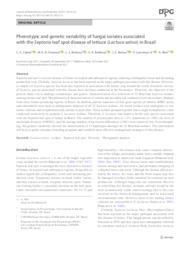Phenotypic and genetic variability of fungal isolates associated with the Septoria leaf spot disease of lettuce (Lactuca sativa) in Brazil.
Phenotypic and genetic variability of fungal isolates associated with the Septoria leaf spot disease of lettuce (Lactuca sativa) in Brazil.
Author(s): CABRAL, C. S.; FONSECA, M. E. N.; BOITEUX, L. S.; BARBOZA, E. A.; VELOSO, J. S.; LOURENÇO JUNIOR, V.; REIS, A.
Summary: Septoria leaf spot is a severe disease of lettuce in tropical and subtropical regions, inducing yield/quality losses and increasing production costs. Globally, Septoria lactucae has been reported as the major pathogen associated with this disease. However, a complex of Septoria species has been also reported in association with lettuce crop around the world. Extensive surveys of Septoria species associated with this disease have not been conducted in the Neotropics. Therefore, the objective of the present study was to undergo a phenotypic and genetic characterization of a collection of 32 Brazilian Septoria isolates causing lettuce leaf spot. Morphometrical characterization of conidia and pycnidia was conducted with ten isolates obtained from three lettuce-producing regions in Brazil. In addition, partial sequences of four gene regions (β-tubulin, RPB2, actin, and calmodulin) were used in phylogenetic analyses of all 32 Septoria isolates. All tested isolates were pathogenic to two lettuce cultivars and morphometrically similar to each other. These isolates grouped together into a single monophyletic clade composed exclusively by genuine S. lactucae isolates. Therefore, S. lactucae was found to be the sole species associated with the Septoria leaf spot of lettuce in Brazil. The number of polymorphic sites (n = 27), mutations (n = 190), the level of nucleotide diversity (0.00262), and the average number of nucleotide differences (2.961) were relatively low. Notwithstanding, this genetic variability allowed the identification of 17 haplotypes amongst the 32 Brazilian isolates. This information will help to guide resistance breeding programs and establish more effective management strategies of this disease.
Publication year: 2022
Types of publication: Journal article
Unit: Embrapa Vegetables
Keywords: Alface, Lactuca Sativa, Phylogenetic analysis, Septoria leaf spot
Observation
Some of Embrapa's publications are published as ePub files. To read them, use or download one of the following free software options to your computer or mobile device. Android: Google Play Books; IOS: iBooks; Windows and Linux: Calibre.
Access other publications
Access the Agricultural Research Database (BDPA) to consult Embrapa's full library collection and records.
Visit Embrapa Bookstore to purchase books and other publications sold by Embrapa.

